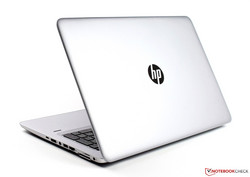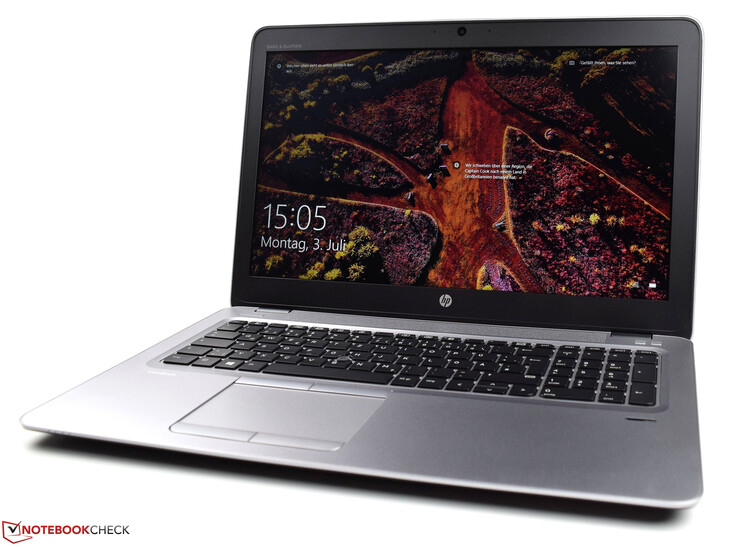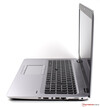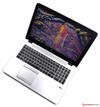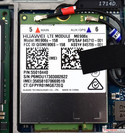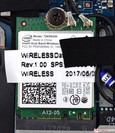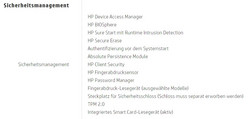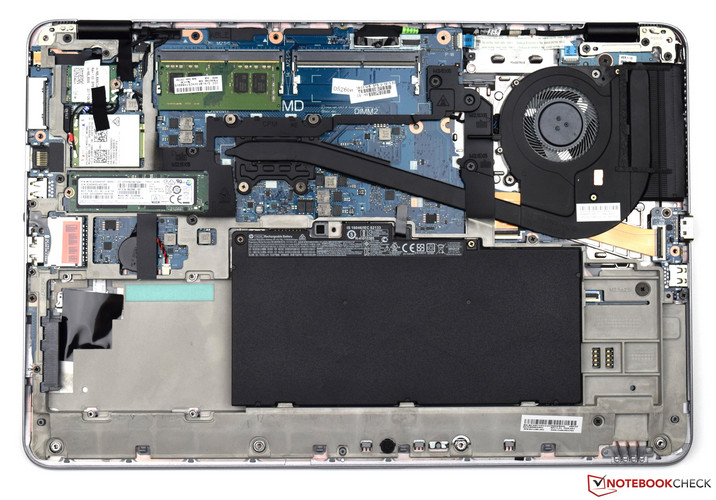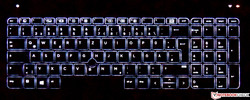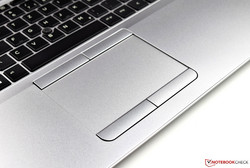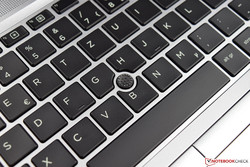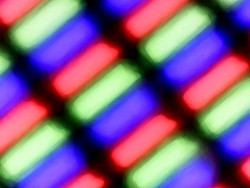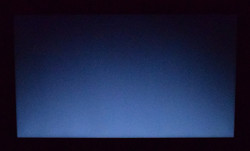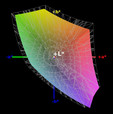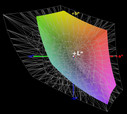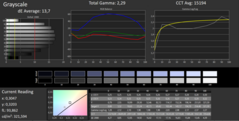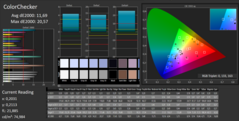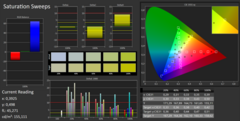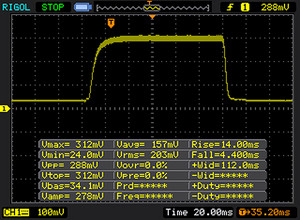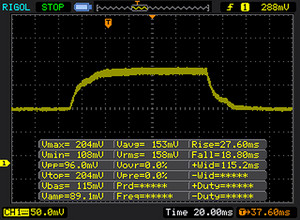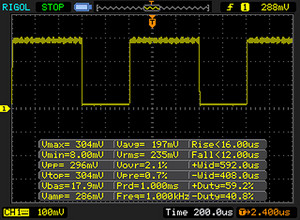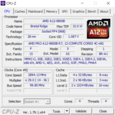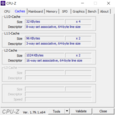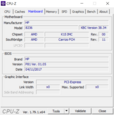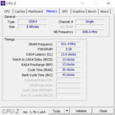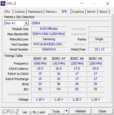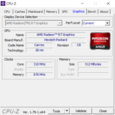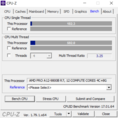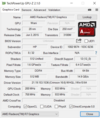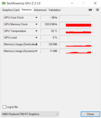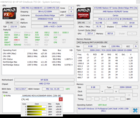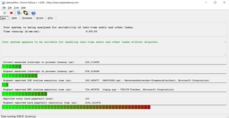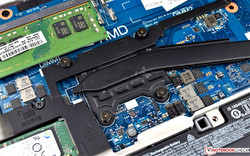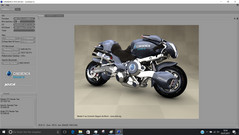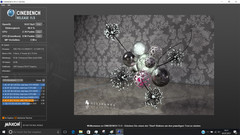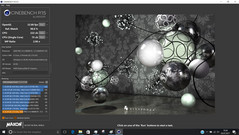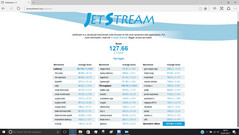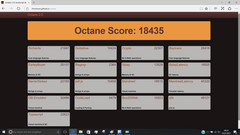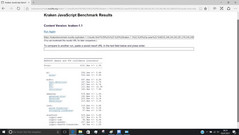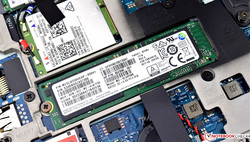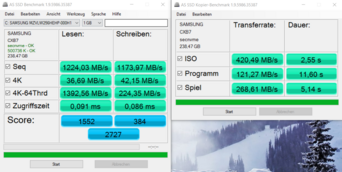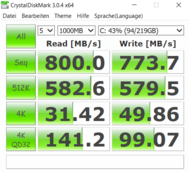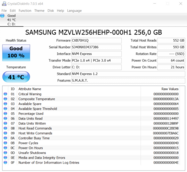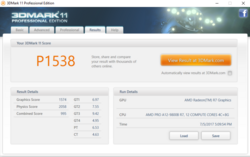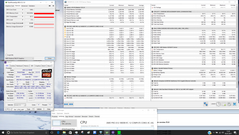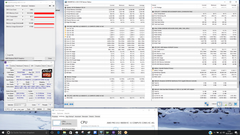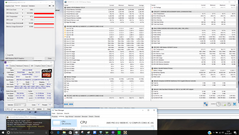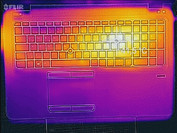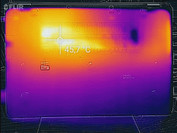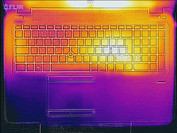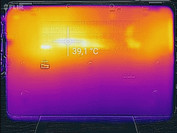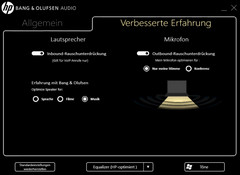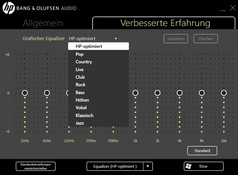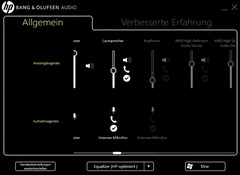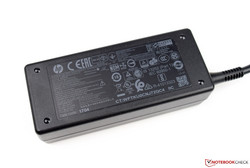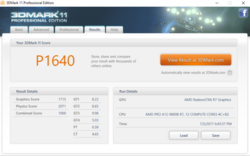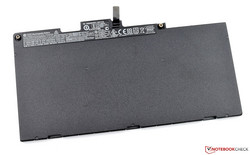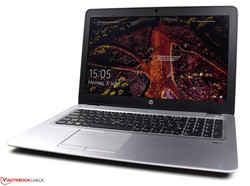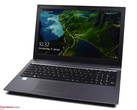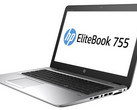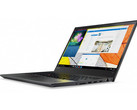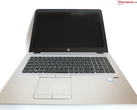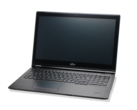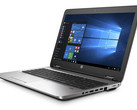HP EliteBook 755 G4 (AMD PRO A12-9800B) Laptop Review

For the original German review, see here.
With the EliteBook series, HP has been firmly established in the business segment for a number of years. The HP EliteBook 755 G4 is no exception here and draws attention with a number of security features.
Unlike many other business companions, HP does not bet on an Intel CPU in the EliteBook 755G4, but provides the business laptop with a processor from AMD. The four-core processor is accompanied by 8 GB of DDR4 RAM. There is also the AMD Radeon R7 as an integrated graphics unit which takes over the graphics output in the processor. Our test unit has a 256-GB SSD for the operating system. The HP EliteBook 755 G4 as equipped in our test unit can be purchased for just under 1500 Euros (~$1700; in the US a similar unit costs about $1100).
The manufacturer offers several configuration options for the HP EliteBook 755 G4. The customer can choose between three different processors of the current AMD-PRO APUs. This will determine the integrated graphics unit in the form of the AMD Radeon R7 or the AMD Radeon R5 which provides the display output. As for the display, the customer can choose between two Full HD panels, since HP also offers a touchscreen for the EliteBook 755 G4. There will also be devices with the slightly more affordable HD display. The RAM and memory storage can be exchanged by the owner without any problems.
In this test, our test unit runs against the competition from Lenovo and Fujitsu. Two of the four comparison devices also come from HP itself. All the competitors are equipped with an Intel Core i5-7200U. It remains to be seen how well the AMD PRO A12-9800B does.
We list all the competing devices and their most important technical specifications in the following table for you.
| Lenovo ThinkPad T570 | HP EliteBook 850 G4 | Fujitsu LifeBook U757 | HP ProBook 650 G2 | |
| CPU | Intel Core i5-7200U | Intel Core i5-7200U | Intel Core i5-7200U | Intel Core i5-6200U |
| GPU | Intel HD Graphics 620 | Intel HD Graphics 620 | Intel HD Graphics 620 | Intel HD Graphics 520 |
| Panel | 15.6 inch 1920x1080 | 15.6 inch 1920x1080 | 15.6 inch 1920x1080 | 15.6 inch 1920x1080 |
| RAM | 8 GB DDR4-2400 | 8 GB DDR4-2133 | 8 GB DDR4-2133 | 8 GB DDR4-2133 |
| Storage | 256 GB (NVMe-SSD) | 256 GB (NVMe-SSD) | 256 GB (SSD) | 256 GB (SSD) |
Case
The case of the EliteBook 755 G4 quite reminiscent of the EliteBook 745 G4, which is available in the market as a 14-inch device. The silver outer case appears high-quality, and the notebook also cuts a good figure in terms of stability. It responds to attempts at twisting with some slight creaking noises. The bottom of the device is black, and unfortunately we are missing a small maintenance flap here. Nonetheless, the bottom can be removed given some time. Both hinges move easily, and the lid can be opened with one hand. Yet, the screen is held in position well and bounces only minimally. The manufacturer highlights the color of the inside of the lid, surrounding the panel with a black plastic frame. Outside, only a discrete HP Logo adorns the display lid, following the motto: less is more.
Size Comparison
With a footprint of 38.3 x 25.7 cm (~15 x 10.1 in), the HP EliteBook 755 G4 uses marginally more space than the comparison devices. With a thickness of 1.94 cm (~0.76 in), our test unit is not too bulky. It should however be mentioned, that with a case thickness of 2.08 cm (~0.82 in), the devices that come with a touchscreen are slightly thicker than our test unit. At 1.8 kg (~4 lb), the weight is quite comfortable for a 15-inch notebook and not too heavy.
Features
Basically, the equipment of the HP EliteBook 755 G4 offers everything a business notebook should have. There are security features in the form of a fingerprint reader and a Kensington Lock port. On the left side, we can find a smartcard reader which can be used for authentication. Due to the sides tapering down towards the front, the remaining connections have to move closer together. There is a full USB 3.0 connection on both sides. It is very good that the manufacturer also provides a USB Type-C connector for the HP EliteBook 755 G4. External monitors can optionally be connected via VGA or DisplayPort. Furthermore, there is a docking connector located towards the back at the right side that allows connecting the device to the appropriate docking station. The placement of the connectors makes sense, but due to the lack of space the connections are very close together on the right side. However, this should not interfere much in everyday life.
SD Card Reader
The card reader is on the right side, just below the DisplayPort connector. The card reader has a protective cover which prevents dust from getting inside. Inserted storage cards stick out slightly, so that there is hardly any danger of damaging them. We tested the performance of the card reader with our reference storage card (Toshiba Exceria Pro SDXC 64 GB UHS-II). During the copying of image files, the HP EliteBook 755 G4 achieved last place with only 55 MB/s. At 79 MB/s, the Fujitsu LifeBook U757 is slightly faster. With 82.6 MB/s during sequential reads, our test unit does not achieve more than last place either. However, the distance behind the Lenovo ThinkPad T570 was only 8%.
| SD Card Reader | |
| average JPG Copy Test (av. of 3 runs) | |
| Fujitsu LifeBook U757 | |
| Lenovo ThinkPad T570-20H90002GE | |
| HP EliteBook 850 G4-Z2W86ET | |
| HP ProBook 650 G2 V1A44ET | |
| HP EliteBook 755 G4 | |
| maximum AS SSD Seq Read Test (1GB) | |
| Lenovo ThinkPad T570-20H90002GE | |
| HP EliteBook 850 G4-Z2W86ET | |
| Fujitsu LifeBook U757 | |
| HP EliteBook 755 G4 | |
Communications
The network connection can optionally be established via LAN or WLAN. Since a Huawei LTE modem is already installed, mobile data transfer is also no problem for the HP EliteBook 755 G4. The Intel WLAN module works very reliably in our test unit. With 504 MBit/s while receiving data, our HP EliteBook 755 G4 falls slightly behind the competition. However, when sending data, our test unit presents itself in a different light. Here we reach an average of 648 MBit/s in our measurements.
During the time of our testing, we did not find any reason for complaint in the wired network connectivity. Even larger amounts of data were always transferred reliably.
| Networking | |
| iperf3 transmit AX12 | |
| HP EliteBook 755 G4 | |
| Lenovo ThinkPad T570-20H90002GE | |
| HP EliteBook 850 G4-Z2W86ET | |
| Fujitsu LifeBook U757 | |
| iperf3 receive AX12 | |
| Fujitsu LifeBook U757 | |
| Lenovo ThinkPad T570-20H90002GE | |
| HP EliteBook 850 G4-Z2W86ET | |
| HP EliteBook 755 G4 | |
Security
The HP EliteBook 755 G4 possesses a number of security features such as a fingerprint sensor, a Trusted Platform Module 2.0 (TPM), and also a smartcard reader. There is also a slot for a security lock (Kensington Lock) on the left side. The software package that HP provides for the EliteBook 755 G4 is equally generous.
Accessories and Delivery Contents
The delivery contents that come with our test device are quite limited. In addition to the device, there is just the small 45-watt smart power supply in the box. The standard brochures, such as security guidelines, warranty information, and a quick-start manual are also included.
The most important accessory for the HP EliteBook 755 G4 is surely the docking station. It ensures order at the work space and extends the connection options. The UltraSlim docking station is listed at HP for 217 Euros (~$245).
Maintenance
The lack of a maintenance flap makes any conceivable maintenance tasks more difficult. However, the bottom can be removed with some care. After the bottom plate has been removed, all the components are easily accessible. Upgrading the RAM or memory storage should not create any huge problems. HP itself points out that the customers can upgrade the RAM themselves. However, we should mention that a special leverage tool is useful to remove the bottom plate to avoid damaging the base.
Warranty
The HP EliteBook 755 G4 comes with a 36-month manufacturer's warranty. This can be extended by the various HP Care Packs, which can optionally be added to the purchase. Please see our Guarantees, Return policies and Warranties FAQ for country-specific information.
Input Devices
Keyboard
The chiclet keyboard of the HP EliteBook 755 G4 is built-in and slightly lowered into the top of the base. With 16 x 16 millimeters (~0.63 x 0.63 in), the keys have a comfortable size. Due to the layout, the two cursor keys (up and down) are slightly wider, but only half as tall. This takes some getting used to, in order to avoid typing mistakes. The keys do not clack, and while writing there are no interfering noises worth mentioning. Although the pressure point is clearly defined, the right amount cannot be easily found, which is not that much of an issue though, since the stroke is relatively small. Thanks to the good contrast of the printed letter symbols, they can be easily read. Furthermore, the HP Premium keyboard is protected from water splashes and has a backlight which facilitates working in dark surroundings. Overall, the keyboard leaves a high-quality impression and fits into the business concept.
Touchpad/TrackPoint
With 10.4 x 6.5 cm (~4.1 x 2.6 in), the touchpad of the EliteBook 755 G4 is not overly large, but not too small in our opinion either. This is a pure touchpad, with two separate input key pairs that are not integrated into the input surface. The sliding characteristics are good, and multitouch gestures are recognized without any problems. In addition, the touchpad supports edge sweeps for faster navigation or scrolling. The two input keys above as well as below the touchpad appear slightly clacky and could have been built a little tighter. The pressure point and stroke is about the same as that of the keys of the chicklet keyboard.
It should also be mentioned that the two top input keys are primarily connected to the TrackPoint. Navigation with the concave TrackPoint takes some getting used to. Anyone experienced with this can move the cursor quickly and precisely with it.
Display
HD, Full HD or Full HD with touch function, these are the three display variants that are available for the HP EliteBook 755 G4. Our test unit is equipped with a Full HD panel from Chi Mei, which achieved an average brightness of 304 cd/m² in our measurements. The full brightness of the display is also available without restrictions in battery operation. However, this is a TN panel, which leads to considerable restrictions of the viewing angles. With a brightness distribution of 82%, the HP EliteBook 755 G4 comes in the last place which is not really laudable. In addition, the very high black value (0.89) leads to a very low contrast ratio of only 374:1. However, it is positive that the 15-inch panel does not have to struggle with screen bleeding. Moreover at 1000 Hz, the measured PWM frequency is relatively high.
| |||||||||||||||||||||||||
Brightness Distribution: 82 %
Center on Battery: 333 cd/m²
Contrast: 374:1 (Black: 0.89 cd/m²)
ΔE ColorChecker Calman: 11.69 | ∀{0.5-29.43 Ø4.78}
ΔE Greyscale Calman: 13.7 | ∀{0.09-98 Ø5}
84% sRGB (Argyll 1.6.3 3D)
54% AdobeRGB 1998 (Argyll 1.6.3 3D)
57.7% AdobeRGB 1998 (Argyll 3D)
84.2% sRGB (Argyll 3D)
56.3% Display P3 (Argyll 3D)
Gamma: 2.29
CCT: 15194 K
| HP EliteBook 755 G4 Chi Mei, CMN15C3, , 1920x1080, 15.6" | Lenovo ThinkPad T570-20H90002GE N156HCA-EAA, , 1920x1080, 15.6" | HP EliteBook 850 G4-Z2W86ET AUO35ED, , 1920x1080, 15.6" | Fujitsu LifeBook U757 LP156WF6-SPP1, , 1920x1080, 15.6" | HP ProBook 650 G2 V1A44ET Chi Mei, , 1920x1080, 15.6" | |
|---|---|---|---|---|---|
| Display | -22% | 1% | 8% | -7% | |
| Display P3 Coverage (%) | 56.3 | 44.08 -22% | 56.8 1% | 65.8 17% | 52.1 -7% |
| sRGB Coverage (%) | 84.2 | 65.6 -22% | 83.7 -1% | 84.8 1% | 78.3 -7% |
| AdobeRGB 1998 Coverage (%) | 57.7 | 45.66 -21% | 58.7 2% | 62 7% | 53.7 -7% |
| Response Times | -4% | 6% | -14% | -21% | |
| Response Time Grey 50% / Grey 80% * (ms) | 45 ? | 41.6 ? 8% | 47.2 ? -5% | 36 ? 20% | 41 ? 9% |
| Response Time Black / White * (ms) | 18 ? | 20.8 ? -16% | 15.2 ? 16% | 26.4 ? -47% | 27 ? -50% |
| PWM Frequency (Hz) | 1000 ? | 26040 ? | 199.2 ? | 200 ? | |
| Screen | 37% | 6% | 46% | 7% | |
| Brightness middle (cd/m²) | 333 | 262 -21% | 338 2% | 313 -6% | 313 -6% |
| Brightness (cd/m²) | 306 | 245 -20% | 341 11% | 294 -4% | 296 -3% |
| Brightness Distribution (%) | 82 | 89 9% | 90 10% | 84 2% | 90 10% |
| Black Level * (cd/m²) | 0.89 | 0.24 73% | 0.81 9% | 0.27 70% | 0.59 34% |
| Contrast (:1) | 374 | 1092 192% | 417 11% | 1159 210% | 531 42% |
| Colorchecker dE 2000 * | 11.69 | 4.5 62% | 10.9 7% | 4.5 62% | 11.89 -2% |
| Colorchecker dE 2000 max. * | 20.57 | 10.5 49% | 18.7 9% | 10.5 49% | 20.81 -1% |
| Greyscale dE 2000 * | 13.7 | 3.5 74% | 13.3 3% | 4 71% | 12.95 5% |
| Gamma | 2.29 96% | 2.32 95% | 2.11 104% | 2.24 98% | 2.4 92% |
| CCT | 15194 43% | 6524 100% | 16030 41% | 6387 102% | 15063 43% |
| Color Space (Percent of AdobeRGB 1998) (%) | 54 | 42.04 -22% | 53.8 0% | 55.3 2% | 50 -7% |
| Color Space (Percent of sRGB) (%) | 84 | 65.4 -22% | 83.4 -1% | 84.74 1% | 78 -7% |
| Total Average (Program / Settings) | 4% /
20% | 4% /
5% | 13% /
30% | -7% /
0% |
* ... smaller is better
The offered display quality is not on the level that is to be expected. The device costs far more than 1000 Euros (~$1130), which is not in accord with the built-in panel. Together, the very high black value and the very low contrast ratio lead to a faded color presentation. In the state of delivery, the average DeltaE-2000 deviations (grayscale and colors) are extremely high (13.7 and 11.69). The color space coverage does not turn out quite as dramatic. However, with 84% of the sRGB color space and a mere 54% of the AdobeRGB color space, the display is not suitable for professional image processing.
We have linked the corresponding ICC profile and as usual, it is available for download. This calibration also removes the blue tint that could be seen in the state of delivery. You can find the link above the comparison chart.
The matte display surface is already a good prerequisite for using it outdoors. However, the average brightness of 304 cd/m² is insufficient to work outdoors in the sun. But there is nothing that speaks against using it outside in the shade.
Display Response Times
| ↔ Response Time Black to White | ||
|---|---|---|
| 18 ms ... rise ↗ and fall ↘ combined | ↗ 14 ms rise | |
| ↘ 4 ms fall | ||
| The screen shows good response rates in our tests, but may be too slow for competitive gamers. In comparison, all tested devices range from 0.1 (minimum) to 240 (maximum) ms. » 39 % of all devices are better. This means that the measured response time is better than the average of all tested devices (20.2 ms). | ||
| ↔ Response Time 50% Grey to 80% Grey | ||
| 45 ms ... rise ↗ and fall ↘ combined | ↗ 27 ms rise | |
| ↘ 18 ms fall | ||
| The screen shows slow response rates in our tests and will be unsatisfactory for gamers. In comparison, all tested devices range from 0.165 (minimum) to 636 (maximum) ms. » 76 % of all devices are better. This means that the measured response time is worse than the average of all tested devices (31.6 ms). | ||
Screen Flickering / PWM (Pulse-Width Modulation)
| Screen flickering / PWM detected | 1000 Hz | ≤ 90 % brightness setting | |
The display backlight flickers at 1000 Hz (worst case, e.g., utilizing PWM) Flickering detected at a brightness setting of 90 % and below. There should be no flickering or PWM above this brightness setting. The frequency of 1000 Hz is quite high, so most users sensitive to PWM should not notice any flickering. In comparison: 53 % of all tested devices do not use PWM to dim the display. If PWM was detected, an average of 8108 (minimum: 5 - maximum: 343500) Hz was measured. | |||
Performance
Our test unit is equipped with an AMD PRO A12-9800B. This processor is the business version based on the AMD FX-9800P, which is a mobile mid-range SoC of the Bristol-Ridge APU series. In our test unit, the processor is accompanied by 8 GB of DDR4 RAM, which can be expanded to 16 GB depending on your needs and the size of your wallet. A 256 GB M.2-SSD contains the operating system and in this case, the only memory storage. There is a second unoccupied 2.5-inch slot available for another drive.
Processor
The AMD PRO A12-9800B, which is built into our test unit, is also the fastest model that is used in the HP EliteBook 755 G4. This is a four-core processor with a basic clock speed of 2.7 GHz. Turbo enables short bursts of up to 3.6 GHz. At 15 watts, it is the same TDP that is also specified for the widespread Intel Core i5-7200U processors.
However, the test shows that the performance of the AMD PRO A12-9800B does not even come close to reaching that of the older Intel Core i5-6200U. In Cinebench R15, the HP EliteBook 755 G4 is clearly beaten. The AMD PRO A12-9800B has no chance against the competitors with the faster Intel processors. In single threaded applications, the performance difference compared to the Intel-Core-i5 processors of the Skylake and Kaby-Lake series is larger than in Multithreaded applications.
You can find further benchmarks of the AMD PRO A12-9800B here.
We test in the continuous Cinebench-R15 loop, how well the processor can maintain the maximum Turbo speed. In our case, the performance already drops by 10% after the second run. However, there are no further performance drops after that.
| Cinebench R11.5 | |
| CPU Single 64Bit | |
| HP EliteBook 755 G4 | |
| CPU Multi 64Bit | |
| HP EliteBook 755 G4 | |
| JetStream 1.1 - Total Score | |
| HP EliteBook 850 G4-Z2W86ET | |
| Lenovo ThinkPad T570-20H90002GE | |
| Fujitsu LifeBook U757 | |
| HP EliteBook 755 G4 | |
| HP ProBook 650 G2 V1A44ET | |
| Octane V2 - Total Score | |
| Lenovo ThinkPad T570-20H90002GE | |
| HP EliteBook 850 G4-Z2W86ET | |
| HP EliteBook 755 G4 | |
| Mozilla Kraken 1.1 - Total | |
| HP EliteBook 755 G4 | |
| HP EliteBook 850 G4-Z2W86ET | |
| Lenovo ThinkPad T570-20H90002GE | |
* ... smaller is better
System Performance
The low CPU performance also results in PCMark8 benchmark values that are not very compelling. The HP EliteBook 755 G4 seems to be fixed in the last place, since all the competing devices are also considerably faster in parts here. Although our test unit is equipped with a fast NVMe SSD, there are some minor latencies, especially right after booting. This phenomenon was very short though, being over after a few seconds. In everyday usage, the device ran smoothly. There were no long wait times, and all the inputs were executed quickly. While the slightly lower CPU performance of the AMD PRO A12-9800B is insufficient to beat the current Intel Core i5 processors, it is sufficient for the everyday office tasks.
| PCMark 8 | |
| Home Score Accelerated v2 | |
| HP EliteBook 850 G4-Z2W86ET | |
| Lenovo ThinkPad T570-20H90002GE | |
| Fujitsu LifeBook U757 | |
| HP ProBook 650 G2 V1A44ET | |
| HP EliteBook 755 G4 | |
| Work Score Accelerated v2 | |
| Lenovo ThinkPad T570-20H90002GE | |
| HP EliteBook 850 G4-Z2W86ET | |
| HP EliteBook 755 G4 | |
| Creative Score Accelerated v2 | |
| Lenovo ThinkPad T570-20H90002GE | |
| HP EliteBook 755 G4 | |
| PCMark 7 | |
| Productivity | |
| HP EliteBook 755 G4 | |
| Score | |
| HP EliteBook 755 G4 | |
| PCMark 7 Score | 7184 points | |
| PCMark 8 Home Score Accelerated v2 | 1579 points | |
| PCMark 8 Creative Score Accelerated v2 | 3292 points | |
| PCMark 8 Work Score Accelerated v2 | 3765 points | |
| PCMark 10 Score | 2332 points | |
Help | ||
Storage Solution
With the Samsung PM961, HP provides the EliteBook 755 G4 with a fast M.2-2280 SSD. According to AS SSD, the SSD manages 1224 MB/s while reading and still 1173 MB/s while writing. In light of the solid 4K performance and the high reliability of the Samsung SSDs, HP has made a very good decision here.
Anyone who needs more storage space can install an additional drive of the 2.5-inch format.
| HP EliteBook 755 G4 Samsung PM961 MZVLW256HEHP | Lenovo ThinkPad T570-20H90002GE Samsung PM961 MZVLW256HEHP | HP EliteBook 850 G4-Z2W86ET Samsung PM951 NVMe MZVLV256 | Fujitsu LifeBook U757 Samsung CM871a MZNTY256HDHP | HP ProBook 650 G2 V1A44ET Sandisk X300 SD7SN6S-256G-1006 | |
|---|---|---|---|---|---|
| CrystalDiskMark 3.0 | 132% | 78% | 36% | 14% | |
| Read Seq (MB/s) | 800 | 1318 65% | 1245 56% | 509 -36% | 475 -41% |
| Write Seq (MB/s) | 774 | 1166 51% | 298.6 -61% | 488.4 -37% | 435 -44% |
| Read 512 (MB/s) | 583 | 933 60% | 673 15% | 414.3 -29% | 280.4 -52% |
| Write 512 (MB/s) | 580 | 860 48% | 298.8 -48% | 321.7 -45% | 265.5 -54% |
| Read 4k (MB/s) | 31.42 | 56.6 80% | 41.79 33% | 36.43 16% | 32.71 4% |
| Write 4k (MB/s) | 49.86 | 130.6 162% | 138.4 178% | 88.4 77% | 98.7 98% |
| Read 4k QD32 (MB/s) | 141.2 | 510 261% | 495 251% | 402.8 185% | 347.2 146% |
| Write 4k QD32 (MB/s) | 99.1 | 426.4 330% | 297.5 200% | 256.7 159% | 154.1 55% |
Graphics Card
The AMD Radeon R7 (Bristol Ridge) alone handles the graphics output in the HP EliteBook 755 G4. It runs at up to 758 MHz and supports Direct X12 (FL12_0). Depending on the 3D application, the AMD Radeon R7 can hold its own against the Intel HD Graphics 620 and put the competition in their places in the 3DMark Fire Strike. The performance of the AMD Radeon R7 can be further increased slightly by a second working memory module.
The integrated graphics unit takes some load of the processor while playing video. This is aided by the Unified Video Decoder (UVD), which is now in its sixth generation and can decode videos in the H.264 or HEVC/H.265 codecs.
You can find further benchmarks of the AMD Radeon R7 here.
| 3DMark | |
| 1280x720 Cloud Gate Standard Graphics | |
| Lenovo ThinkPad T570-20H90002GE | |
| HP EliteBook 850 G4-Z2W86ET | |
| HP EliteBook 755 G4 | |
| 1920x1080 Fire Strike Graphics | |
| HP EliteBook 755 G4 | |
| Lenovo ThinkPad T570-20H90002GE | |
| HP EliteBook 850 G4-Z2W86ET | |
| 3DMark 11 - 1280x720 Performance GPU | |
| HP EliteBook 755 G4 | |
| Lenovo ThinkPad T570-20H90002GE | |
| HP EliteBook 850 G4-Z2W86ET | |
| Fujitsu LifeBook U757 | |
| HP ProBook 650 G2 V1A44ET | |
| 3DMark 11 Performance | 1737 points | |
| 3DMark Ice Storm Standard Score | 37561 points | |
| 3DMark Cloud Gate Standard Score | 3897 points | |
| 3DMark Fire Strike Score | 833 points | |
| 3DMark Fire Strike Extreme Score | 417 points | |
| 3DMark Time Spy Score | 358 points | |
Help | ||
Gaming Performance
The performance of the built-in APU is insufficient to play power-hungry games such as "The Witcher 3" or "Rise of the Tomb Raider" smoothly. Even older games can often only be played smoothly with minimal graphics settings. Even though the graphics performance can be slightly improved by using a second RAM module, you should not expect too much performance increase.
| low | med. | high | ultra | |
|---|---|---|---|---|
| BioShock Infinite (2013) | 46.2 | 27.9 | 22.5 | 7.8 |
| Battlefield 4 (2013) | 32.5 | 22.8 | 15.2 | 5.6 |
| The Witcher 3 (2015) | 11.9 | 7.6 | ||
| Rise of the Tomb Raider (2016) | 20.6 | 12.4 | 6.2 |
Emissions
Noise Emissions
Without load, the HP EliteBook 755 G4 runs silently. The fan is turned off and only starts running under load. But even then it is rather restrained, and even under maximum load we only measure 32.8 dB(A). Thus the device runs very quietly which is rather positive for the other colleagues in the office.
Noise level
| Idle |
| 29.9 / 29.9 / 29.9 dB(A) |
| Load |
| 30.9 / 32.8 dB(A) |
 | ||
30 dB silent 40 dB(A) audible 50 dB(A) loud |
||
min: | ||
| HP EliteBook 755 G4 PRO A12-9800B, Radeon R7 (Bristol Ridge) | Lenovo ThinkPad T570-20H90002GE i5-7200U, HD Graphics 620 | HP EliteBook 850 G4-Z2W86ET i5-7200U, HD Graphics 620 | Fujitsu LifeBook U757 i5-7200U, HD Graphics 620 | HP ProBook 650 G2 V1A44ET 6200U, HD Graphics 520 | |
|---|---|---|---|---|---|
| Noise | -5% | 2% | 2% | -6% | |
| off / environment * (dB) | 29.9 | 29.3 2% | 29 3% | 28.2 6% | 30.5 -2% |
| Idle Minimum * (dB) | 29.9 | 29.3 2% | 29 3% | 28.2 6% | 30.5 -2% |
| Idle Average * (dB) | 29.9 | 29.3 2% | 29 3% | 28.2 6% | 31.6 -6% |
| Idle Maximum * (dB) | 29.9 | 31.2 -4% | 29 3% | 28.2 6% | 31.9 -7% |
| Load Average * (dB) | 30.9 | 35.1 -14% | 31 -0% | 33.3 -8% | 34.7 -12% |
| Load Maximum * (dB) | 32.8 | 38.7 -18% | 33.4 -2% | 34 -4% | 34.5 -5% |
* ... smaller is better
Temperature
The HP EliteBook 755 G4 had no temperature problems at all. During load, we measured a maximum case temperature of 35.7 °C (~96 °F) on the top. We also have no concerns about doing work on our laps, since the bottom warms to barely 32 °C (~89.6 °F).
During the load test, the processor heats up to a maximum of 56 °C (~133 °F). If both the FurMark and the Prim95 test programs run simultaneously, the CPU and GPU have to share the 15-watt TPD. For this reason, the processor is throttled to 800 MHz. The integrated graphics unit fluctuated on and off and ran with an average 386 MHz clock speed.
Right after the load test, we tested the 3D performance again by running the 3DMark 11 benchmark. At 1538 points, the result is now slightly lower in comparison to the cold start. Still, in our opinion there is no noticeable performance drop in everyday life.
(+) The maximum temperature on the upper side is 35.7 °C / 96 F, compared to the average of 34.3 °C / 94 F, ranging from 21.2 to 62.5 °C for the class Office.
(+) The bottom heats up to a maximum of 31.8 °C / 89 F, compared to the average of 36.8 °C / 98 F
(+) In idle usage, the average temperature for the upper side is 28.1 °C / 83 F, compared to the device average of 29.5 °C / 85 F.
(+) The palmrests and touchpad are cooler than skin temperature with a maximum of 28.1 °C / 82.6 F and are therefore cool to the touch.
(±) The average temperature of the palmrest area of similar devices was 27.6 °C / 81.7 F (-0.5 °C / -0.9 F).
| HP EliteBook 755 G4 PRO A12-9800B, Radeon R7 (Bristol Ridge) | Lenovo ThinkPad T570-20H90002GE i5-7200U, HD Graphics 620 | HP EliteBook 850 G4-Z2W86ET i5-7200U, HD Graphics 620 | Fujitsu LifeBook U757 i5-7200U, HD Graphics 620 | HP ProBook 650 G2 V1A44ET 6200U, HD Graphics 520 | |
|---|---|---|---|---|---|
| Heat | -6% | 5% | -4% | -9% | |
| Maximum Upper Side * (°C) | 35.7 | 39.5 -11% | 37 -4% | 42 -18% | 39.6 -11% |
| Maximum Bottom * (°C) | 31.8 | 48.3 -52% | 41.1 -29% | 38.8 -22% | 41.8 -31% |
| Idle Upper Side * (°C) | 30.9 | 24.5 21% | 23.2 25% | 29.2 6% | 31.6 -2% |
| Idle Bottom * (°C) | 31.8 | 25.3 20% | 23.2 27% | 26.3 17% | 29.7 7% |
* ... smaller is better
Speakers
As in many other EliteBooks before, we also find a sound system from Bang & Olufsen in the current HP EliteBook 755 G4. In light of the compact build, the sound quality is surprisingly good. Of course the mids and highs continue to predominate, but in addition you can distinguish the beginnings of some bass, which is not completely left out. The speakers are placed above the keyboard. From there, the sound can emit without hindrance, and the EliteBook 755 G4 does not care what sort of surface it stands on.
The included software from Bang & Olufsen offers a multitude of adjustments, allowing adjusting the sound of the speakers optimally to your own personal preference. Likewise, with the software you can also activate additional noise suppression for the microphone, so nothing stands in the way of video calling.
HP EliteBook 755 G4 audio analysis
(-) | not very loud speakers (68 dB)
Bass 100 - 315 Hz
(-) | nearly no bass - on average 20.7% lower than median
(±) | linearity of bass is average (12.8% delta to prev. frequency)
Mids 400 - 2000 Hz
(+) | balanced mids - only 1.6% away from median
(±) | linearity of mids is average (10.2% delta to prev. frequency)
Highs 2 - 16 kHz
(+) | balanced highs - only 2.6% away from median
(+) | highs are linear (3.4% delta to prev. frequency)
Overall 100 - 16.000 Hz
(±) | linearity of overall sound is average (17.5% difference to median)
Compared to same class
» 26% of all tested devices in this class were better, 7% similar, 67% worse
» The best had a delta of 7%, average was 21%, worst was 53%
Compared to all devices tested
» 33% of all tested devices were better, 8% similar, 59% worse
» The best had a delta of 4%, average was 24%, worst was 134%
HP EliteBook 850 G4-Z2W86ET audio analysis
(±) | speaker loudness is average but good (74.6 dB)
Bass 100 - 315 Hz
(-) | nearly no bass - on average 15.5% lower than median
(±) | linearity of bass is average (11% delta to prev. frequency)
Mids 400 - 2000 Hz
(+) | balanced mids - only 1.7% away from median
(+) | mids are linear (3.8% delta to prev. frequency)
Highs 2 - 16 kHz
(+) | balanced highs - only 3.2% away from median
(±) | linearity of highs is average (7.6% delta to prev. frequency)
Overall 100 - 16.000 Hz
(±) | linearity of overall sound is average (17.7% difference to median)
Compared to same class
» 27% of all tested devices in this class were better, 6% similar, 66% worse
» The best had a delta of 7%, average was 21%, worst was 53%
Compared to all devices tested
» 34% of all tested devices were better, 8% similar, 58% worse
» The best had a delta of 4%, average was 24%, worst was 134%
Frequency comparison (Checkboxes selectable!)
Power Management
Power Consumption
The power demands of the HP EliteBook 755 G4 are too high in idle operation. The comparison chart shows that our test unit loses most of its percentage points there. At 7 to 11 watts, the HP EliteBook 755 G4 uses considerably more than its energy efficient competitors that are equipped with Intel's ULV processors. During average load in the first scene of the 3DMark 06, all devices run head to head. At 30.5 watts, our laptop with the AMD CPU is not out of place anymore. At 36.1 watts during peaks, the HP EliteBook 755 G4 uses considerably less than the Lenovo ThinkPad T570 (46.1 watts).
The included power supply can provide a maximum of 45 watts. Thus there are no concerns, and the maximum loads on the power supply are also not exceeded when using another drive.
| Off / Standby | |
| Idle | |
| Load |
|
Key:
min: | |
| HP EliteBook 755 G4 PRO A12-9800B, Radeon R7 (Bristol Ridge), Samsung PM961 MZVLW256HEHP, TN LED, 1920x1080, 15.6" | Lenovo ThinkPad T570-20H90002GE i5-7200U, HD Graphics 620, Samsung PM961 MZVLW256HEHP, IPS, 1920x1080, 15.6" | HP EliteBook 850 G4-Z2W86ET i5-7200U, HD Graphics 620, Samsung PM951 NVMe MZVLV256, TN LED, 1920x1080, 15.6" | Fujitsu LifeBook U757 i5-7200U, HD Graphics 620, Samsung CM871a MZNTY256HDHP, IPS LED, 1920x1080, 15.6" | HP ProBook 650 G2 V1A44ET 6200U, HD Graphics 520, Sandisk X300 SD7SN6S-256G-1006, TN LED, 1920x1080, 15.6" | |
|---|---|---|---|---|---|
| Power Consumption | 15% | 25% | 22% | 28% | |
| Idle Minimum * (Watt) | 7 | 3.6 49% | 3.58 49% | 3.96 43% | 3.4 51% |
| Idle Average * (Watt) | 10.9 | 7.7 29% | 5.97 45% | 7.74 29% | 7.5 31% |
| Idle Maximum * (Watt) | 11 | 8.2 25% | 6.81 38% | 8.64 21% | 7.6 31% |
| Load Average * (Watt) | 30.5 | 30.8 -1% | 29.4 4% | 28.8 6% | 28.4 7% |
| Load Maximum * (Watt) | 36.1 | 46.1 -28% | 39.7 -10% | 32 11% | 28.4 21% |
* ... smaller is better
Battery Life
The 51-Wh Lithium-Ion battery is built-in and can supply the device with power for 12 hours during idle operation. During load, a full battery charge lasts for a runtime of only 113 minutes, before the device retires. In our practically more relevant WLAN test, the HP EliteBook 755 G4 achieved a runtime of 4:19 hours. Anyone who likes to watch movies will be able to barely watch three movies of normal length on a single charge.
Compared to the remaining four competitors, things look quite bleak for our test device in this comparison. During idle operation in particular, the very efficient ULV processors from Intel save a lot of power, which is the reason for such differences in battery life here. The AMD processor is simply too power-hungry during idle.
| HP EliteBook 755 G4 PRO A12-9800B, Radeon R7 (Bristol Ridge), 51 Wh | Lenovo ThinkPad T570-20H90002GE i5-7200U, HD Graphics 620, 56 Wh | HP EliteBook 850 G4-Z2W86ET i5-7200U, HD Graphics 620, 51 Wh | Fujitsu LifeBook U757 i5-7200U, HD Graphics 620, 50 Wh | HP ProBook 650 G2 V1A44ET 6200U, HD Graphics 520, 48 Wh | |
|---|---|---|---|---|---|
| Battery runtime | 83% | 82% | 70% | 65% | |
| Reader / Idle (h) | 12.3 | 19.5 59% | 18 46% | ||
| H.264 (h) | 4.5 | 9.8 118% | 10.6 136% | ||
| WiFi v1.3 (h) | 4.3 | 7.6 77% | 8.8 105% | 7.3 70% | 7.1 65% |
| Load (h) | 1.9 | 3.4 79% | 2.7 42% |
Verdict
Pros
Cons
The HP EliteBook 755 G4 is a business laptop in the 15-inch format. The AMD processor is sufficient for the envisioned usages, although it also has some disadvantages. Furthermore, the notebook provided to us is equipped with 8 GB of DDR4-RAM and a fast 256 GB SSD in the M.2-2280 format and can be currently purchased for 1460 Euros (~$1650). We quite liked the clean workmanship that did not deserve any complaints. We also liked the looks that appear very discrete and elegant. Thanks to the good material selection, the base is very stable and thus quite suitable for daily use.
The HP EliteBook 755 G4 is a good business device that brings many security features in an entry device. With the HP EliteBook 755 G4, anyone for whom the performance of the AMD processor is sufficient receives a good work device equipped with modern connections.
Our strongest complaints go towards the display which makes it a less rounded package. The quality simply does not match the EliteBook series. The manufacturer should check if this quality level does justice to the real goal. Another complaint results from the somewhat power-hungry processor, which leads to the short battery life.
We are a little split on the lack of a maintenance flap, since the bottom of the case can be removed with a little time. A maintenance flap would be more customer friendly in our opinion. We liked the sound quality, the keyboard, and the fast SSD which benefits the system most.
HP EliteBook 755 G4
- 07/12/2017 v6 (old)
Sebastian Bade




